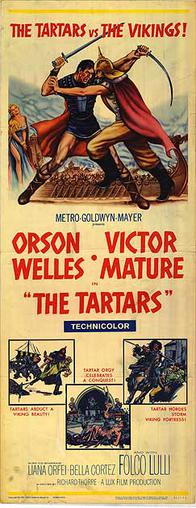Plot
In what is now Russia, a settlement of Vikings lives in peace with both the Tatars and the Slavs. All is well until Togrul (Folco Lulli), a Tatar chief seeks the help of Oleg (Victor Mature), the chief of the Vikings, to war on the Slavs in a surprise attack. Oleg refuses and the group does battle ending with Oleg killing Togrul and abducting Togrul's daughter Samia (Bella Cortez) as a hostage.
Togrul's brother Burundai (Orson Welles) is furious and wishes the Viking settlement burnt to the ground. "I am your Khan", he says to his troops. His high priest, Ciu Lang (Arnoldo Foà), reminds Burundai that Samia is promised to the leader of the Tatars as his wife; her safety and return has a higher priority than Burundai's revenge. Burundai gets his chance to retrieve Samia when a Viking longship is attacked, resulting in the capture of Oleg's wife Helga (Liana Orfei) and her handmaidens. Burundai initially promises to treat Helga well as an exchange for Samia but tortures Helga's handmaidens to discover the strength of the Vikings. He also rapes Helga and gives her to his men for their further pleasure prior to exchanging her for Samia. Meanwhile, Samia has fallen in love with Oleg's brother Eric (Luciano Marin).
When Oleg comes to make the exchange and Ciu Lang leads Helga out to the battlements of the Tatar fortress, she leaps down upon seeing Oleg below and is fatally injured. He takes her and Samia back to the Viking settlement, where Helga asks him to kiss her and dies. The grief-stricken Oleg is ready to kill Samia, but Eric reveals that she is pregnant by him and demands to marry her. Oleg has them tried for their lives by the tribal elders. Meanwhile, Ciu Lang counsels Burundai to get Samia back peacefully, but he has megalomaniac dreams of conquering the whole West, and he kills the priest and goes to lead the Tatars to wipe out the Vikings.
At the trial of Eric and Samia, the elders split their votes evenly between acquittal and death, leaving Oleg to cast the deciding vote. Just as he is about to, word comes that Burundai is attacking. He tells Eric to earn the second chance this gives him, organizes the women and children to flee to the Vikings in the mountains, and he and Eric lead the defense of the settlement by the men. The Tatars outnumber them and overwhelm the defenses; Oleg tells Eric to take Samia and go, and Eric rescues her from Tatar soldiers and gets her to a longship. Oleg fights Burundai, throws him into the water and drowns him; as he is saluting Eric and Samia on board their ship, a Tatar spear strikes him and kills him. The longship moves off as the settlement burns.
This page is based on this
Wikipedia article Text is available under the
CC BY-SA 4.0 license; additional terms may apply.
Images, videos and audio are available under their respective licenses.
